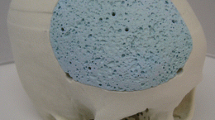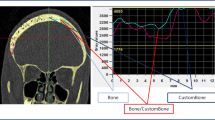Summary
The author has designed new cranioplastic materials to reconstruct a skull defect of moderate size in both the convexity and the suboccipital region. A domed and elliptic plate measuring 50×75 mm in diameter, 12 mm in the maximum height and 5 mm in thickness was made from hydroxylapatite ceramics. The latter comprise Ca10(PO4)6(OH)2 as mammalian bone minerals and are characterized by an excellent biocompatibility and biostability resulting in bony fusion. Hydroxylapatite ceramic plates can be easily trimmed during surgery to closely fit the skull defect. There were no adverse reactions nor resorption of the implants.
Similar content being viewed by others
References
Beumer J III, Firtell DN, Curtis TA (1979) Current concepts in cranioplasty. J Prosthet Dent 42: 67–77
De Benedetti G, Marra A, Crivelli G, Pozzi M (1981) A fast, simple, and satisfactory method of cranioplasty. Surg Neurol 15: 358–360
Denissen HW, De Groot K, Makkes PCh, Van Den Hooff A, Klopper PJ (1980) Tissue response to dense apatite implants in rats. J Biomed Mater Res 14: 713–721
Elikins CW, Cameron JE (1946) Cranioplasty with acrylic plates. J Neurosurg 3: 199–205
Kobayashi S, Ammar AS, Sugita K, Makinouchi K (1983) Comparative studies on impact strength of human cranium, alumina ceramics and resin. Proc Orthop Ceramic Implants 3: 235–238
Kobayashi S, Hara H, Okudera H, Takemae T, Sugita K (1987) Usefulness of ceramic implants in neurosurgery. Neurosurg 21: 751–755
Korlof B, Nylen B, Rietz KA (1973) Bone grafting of skull defects. A report on 55 cases. Plast Reconstr Surg 52: 378–383
Koyama T, Handa J (1986) Porous hydroxylapatite ceramics for use in neurosurgical practice. Surg Neurol 25: 71–73
Kyoshima K, Gibo H, Kobayashi S, Sugita K (1985) Cranioplasty with inner table of bone flap. J Neurosurg 62: 607–609
Linder L (1976) Tissue reaction to methyl methacrylate monomer: A comparative study in the rabbit's ear on the toxicity of methyl methacrylate monomer of varying composition. Acta Orthop Scand 47: 3–9
Psillakis JM, Nocchi VLB, Zanini SA (1979) Repair of large defect of frontal bone with free graft of outer table of parietal bones. Plast Reconstr Surg 64: 827–830
Yamaki T, Odake G, Horikawa Y, Suzuki K, Fujimoto M, Naruse S, Yano I, Ota T, Toyama M (1978) Clinical and experimental study of heat-cured methyl methacrylate for cranioplasty. Neurol Med Chir (Tokyo) 18: 323–329
Yamashima T (1988) Reconstruction of surgical skull defects with hydroxylapatite ceramic buttons and granules. Acta Neurochir (Wien) 90: 157–162
Author information
Authors and Affiliations
Rights and permissions
About this article
Cite this article
Yamashima, T. Cranioplasty with hydroxylapatite ceramic plates that can easily be trimmed during surgery. Acta neurochir 96, 149–153 (1989). https://doi.org/10.1007/BF01456175
Issue Date:
DOI: https://doi.org/10.1007/BF01456175




